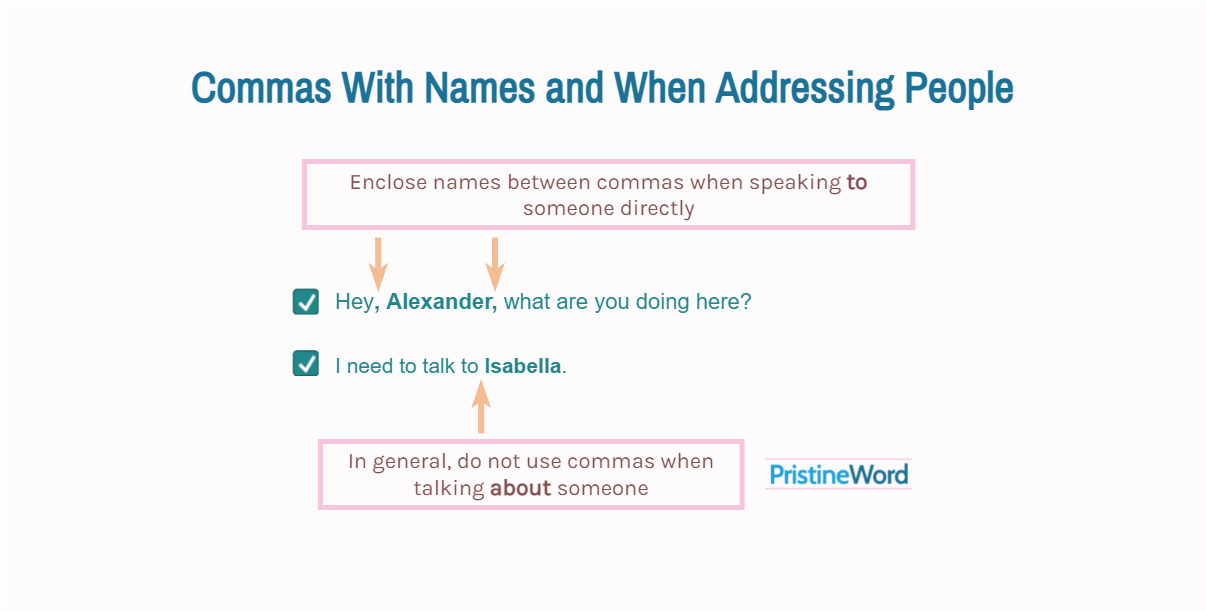Enclose names between commas when speaking to someone directly (e.g., in dialogue). In general, do not use commas when talking about someone (instead of talking to someone).
Enclose names between commas when speaking to someone directly (e.g., in dialogue).
Hey, Alexander, what are you doing here?
Hey Alexander what are you doing here?
In general, do not use commas when talking about someone (instead of talking to someone).
Sophia is studying Japanese.
Sophia, is studying Japanese.
Contents
1. "Talking To" vs. "Talking About" (Someone)
Look at this sentence:
It's so nice to see you, Jenny.
In the example above, we are speaking to Jenny; that is, we are addressing her directly.
Jenny is a talented young girl.
In this sentence, though, we are talking about Jenny, not speaking to her directly.
2. Commas When Talking to Someone (Direct Address)
Commas of direct address are used when someone is being spoken directly; that is, place the name between commas when using direct address.
Well, Oliver, I need to tell you something.
Well Oliver I need to tell you something.
If the name appears at the start (or at the end) of the sentence, add only a comma.
Alice, can you pass me the salt?
Sit down, Rebecca.
Other quotation marks, such as periods or exclamation marks, replace a comma.
Alex! Sit down.
Do not forget that we use these commas when talking to somebody, not when talking about somebody. We only need commas when someone is directly addressed.
Have you seen Olivia lately?
Have you seen, Olivia, lately?
Follow the same strategy when using commas with academic degrees, titles or other terms instead of an actual name, such as Sir, Professor, Ph.D., Captain, dude, guys, my friend, etc.
Hey, guys, what are you doing here?
Good morning, sweetie.
Good evening, Sir.
More Examples
- Hey, James, it's nice to see you again.
- Can I help you, sir?
- John, can you help me deal with this issue?
- I did it all for you because I love you, sweetheart.
- William, walk me through this process, please.
- I promise you won't regret it, Charlotte.
- Hi! My friend, how long have you been working here?
- Good morning, captain.
3. Commas When Talking About Someone
In general, do not use a comma before or after a person's name when talking about someone.
Jim is aggressive and bossy.
Jim is aggressive and bossy.
Another example:
I need to talk to Isabella.
When a person's name is followed by a description
Sometimes, however, a person's name is followed by a description (e.g., John, my best friend, is here.)
If somebody is sufficiently identified, the description that follows is considered non-essential and should be surrounded by commas.(1)
Charlotte, who has failed the exam, is furious.
Charlotte who has failed the exam is furious.
Recommended: Use of commas before who.
However, when someone is not sufficiently identified, the description is relevant to know who we are talking about. We should not use commas in this case.
My uncle John is tall.
This sentence implies that I have more than one uncle. "John" is important to know who I am talking about, so no commas enclose "John".
Conversely, if the speaker has only one uncle, the subject is sufficiently identified and "John" should be surrounded by commas.
My uncle, John, is tall.
Another example:
My sister Emma is working in New York.
The absence of comma indicates that I have more than one sister. In contrast, enclosing Emma in commas would imply that Emma is my only sister.
Follow the same rules when using other terms to refer to someone or a group.
My friend Amelia can speak four languages.
My best friend, Amelia, can speak four languages.
Adding extra information after a name
A person's name can also be followed by additional information. Use commas if this information can be safely omitted without changing the meaning of the sentence. For example:
Mia, knowing that it was late, turned off the TV and went to bed.
"Knowing that it was late" provides additional information, which can be removed without changing the meaning of the sentence. It does not define or limit. These phrases, also called parenthetic expressions, should be enclosed between commas.(2)
More Examples
- Your boyfriend, Lucas, is the tallest high-school basketball player.
- Your friend Olivia is looking for a new job.
- Jenny, who is a doctor, can prescribe drugs.
- James, my worst enemy, can't stop lying.
- Alexander the Great conquered the world.
- Mia, your girlfriend, likes playing video games.
4. Conclusion
These guidelines will help you punctuate names as well as use commas correctly when addressing people:
- Enclose names between commas when addressing someone directly.
- Do not use commas when talking about someone indirectly, unless you are adding non-essential information before or after the person's name.
5. References
(1) Kaufman, Lester; Straus, Jane. The Blue Book of Grammar and Punctuation. Chapter 2 (punctuation).
(2) Strunk JR., William; White, E.B. The Elements of Style. Chapter 1 - Elementary Rules of Usage.

